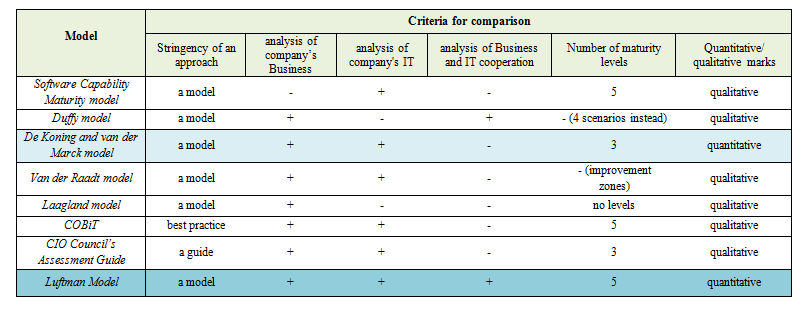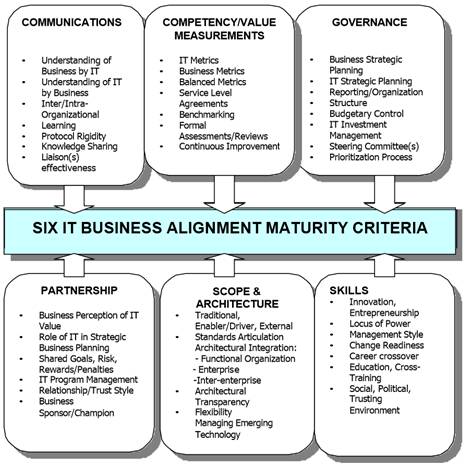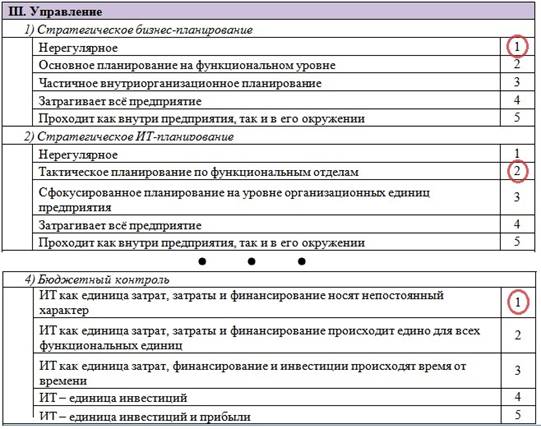ИССЛЕДОВАНИЕ МЕТОДОВ ОЦЕНКИ ЗРЕЛОСТИ СТРАТЕГИЧЕСКОГО ВЫРАВНИВНИЯ БИЗНЕСА И ИТ
Лисиенкова Т.С.
НИУ – Высшая Школа Экономики
ИССЛЕДОВАНИЕ МЕТОДОВ ОЦЕНКИ ЗРЕЛОСТИ СТРАТЕГИЧЕСКОГО ВЫРАВНИВНИЯ БИЗНЕСА И ИТ
Аннотация
В статье рассмотрены различные подходы к оценке зрелости процесса стратегического выравнивания, который заключается во взаимовыгодном сосуществовании Бизнеса и ИТ в рамках одного предприятия. Сравнительный анализ методов мировой практики позволил выбрать наиболее подходящий для адаптации и дальнейшего применения в российских компаниях.
Ключевые слова: стратегическое выравнивание Бизнеса и ИТ, оценка зрелости стратегического выравнивания, модель Люфтмана.
Lisienkova T.S.
NRU – Higher School of Economics
RESEARCH OF APPROACHES TO BUSINESS AND IT STRATEGIC ALIGNMENT EVALUATION
Abstract
The article touches upon different approaches to the evaluation of strategic alignment process which can be considered as beneficial coexistence of Business and IT within one company. Comparative analysis of global best practices was held in order to choose the most suitable one for adaptation and further implementation in Russian companies.
Key words: Business and IT strategic alignment, strategic alignment evaluation, a Luftman model.
Nowadays much attention is given to information technology (IT) on the enterprise. "Unhealthy" relationship between Business and IT leads a company to some serious problems. According to the Society of Information Management Report, IT-problems may cause the following consequences [1, p. 8]:
- loss of company’s competitive advantage; spoil of corporate reputation;
- IT-projects exceeding its time, financial and source limits;
- negative influence on corporate efficiency and core business-processes;
These problems may occur because of a lack of cohesion between IT and Business in a company. Several decades ago a key term was introduced [2]. It is Business and IT strategic alignment, which means beneficial coexistence of Business and IT.
In the USA and some European countries there is a class of maturity models of strategic alignment; they evaluate the current situation in a company in terms of Business and IT cooperation. However, there is a little data about usage of such models in Russia. The goal of this project is to research different approaches to the evaluation of Business and IT strategic alignment that could be later applied in Russian companies.
To achieve this goal the following tasks are to be completed:
- Analysis of models for Business and IT strategic alignment maturity evaluation;
- Adaptation of Business and IT strategic alignment evaluation model for Russian companies;
Approaches to evaluation of Business and IT maturity
Software capability maturity model
One of the first maturity models in IT sector was introduced by Software Engineering Institute (SEI) in the middle 1980-s [3]. The problem of mismatch between customer requests and resulting software as well as exceeding time and financial limits was actual for that time. Thus, SEI intended to analyze and describe reference business processes of companies which were the software developers. As a result, some kind of questionnaire with full description of 5 maturity levels was published; later this questionnaire became a valuable model. However, this model was rather specific as it covered only IT companies and did not consider Business component of companies.
Other models that were analyzed in the same manner at the first step of this research are [3]:
- Duffy mode,
- De Konig and vann der Mark model,
- Vann der Raadt model,
- Laagland model,
- COBiT maturity model,
- CIO Council’s Assessment Guide,
- Luftman model.
In order to compare the analyzed models, several criteria were formulated. Which are:
- Stringency of an approach,
- If there is analysis of company’s Business,
- If there is analysis of company's IT,
- If there is analysis of Business and IT cooperation,
- Number of maturity levels,
- If evaluation is quantitative or qualitative.
The investigated models were analyzed and compared according to the formulated criteria (table 1).
Table 1. Comparison table of models for strategic alignment maturity evaluation
As for this research the Luftman model [4] tends to be of the greatest interest as it describes the ways how different departments as well as their executives should cooperate with each other most efficiently.
The second stage of a project was dedicated to the model adaptation for Russian companies. Before any adaptation it is worth researching model components. Firstly, the theoretical description of a model suggests that strategic alignment should be based on the effective communication between 4 big company parts (business strategy, organizational structure, IT strategy and IT infrastructure). The next component of the Luftman model are 6 groups of criteria which evaluate strategic alignment maturity. Groups with related criteria are presented in Figure 1.
Figure 1. Alignment maturity criteria
Maturity levels are also considered as essential component of the Luftman model. Each of 5 levels defined in the model where level 1 is the lowest one and level 5 is the highest describes alignment criteria in a certain way. As a major tool to evaluate strategic alignment, a questionnaire was developed. It includes 6 sets of questions for each alignment criterion. A part of developed questionnaire is presented on figure 2; the rest of the sets are composed in a similar manner.
Figure 2. A part of developed questionnaire
On the final step an evaluation scale was developed. Each statement in the questionnaire is marked with a certain number which stands for maturity level; applying arithmetical means to each set allows calculating overall maturity level
Summing the results up, several existing approaches to the strategic alignment evaluation were analyzed. The Luftman model was adapted for Russian companies. Model’s components were translated and customized with due regard to features of Russian business; a questionnaire and evaluation tool were developed.
The results of this research may be potentially of great practical interest as they will allow to analyze the common level of strategic alignment on the Russian market.
References
- IT Governance Institute. Board briefing on IT governance. – Information Systems Audit and Control Foundation, 2001.
- Henderson J. C., Venkatraman N. Strategic alignment: a model for organizational transformation through information technology // Transforming organizations. – 1992. – P. 97-117.
- Santana Tapia R. G. et al. Towards a business-IT alignment maturity model for collaborative networked organizations. – 2008.
- Luftman J. Assessing IT/business alignment // Information Systems Management. – 2003. – 20 (4). – P. 9-34.



